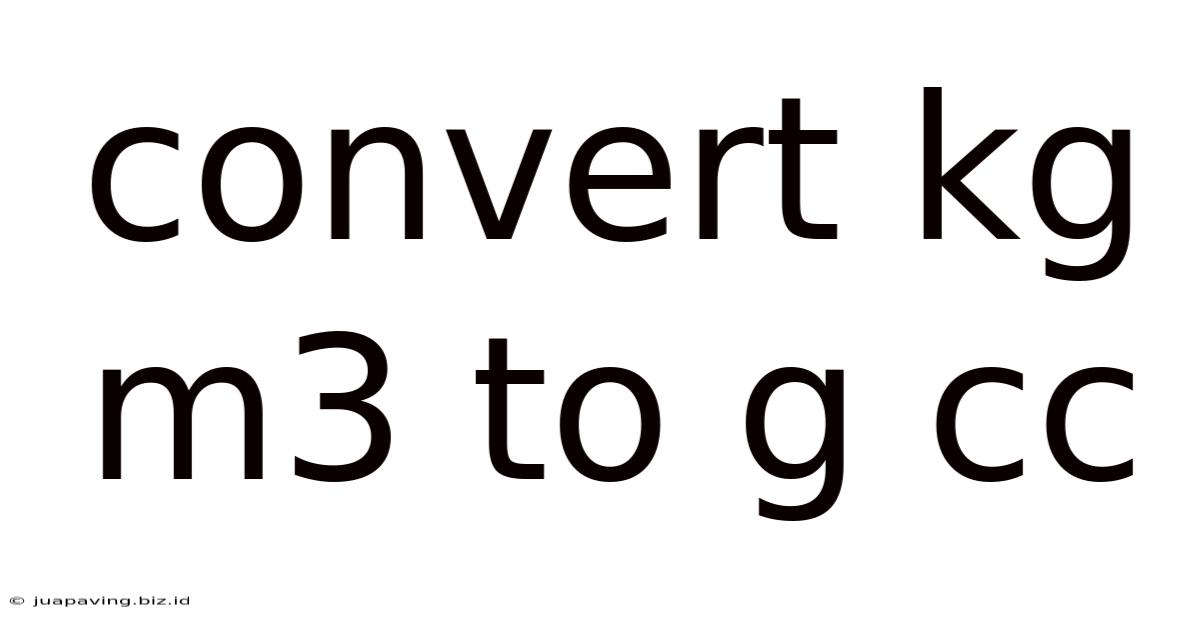Convert Kg M3 To G Cc
Juapaving
May 13, 2025 · 4 min read

Table of Contents
Converting kg/m³ to g/cm³: A Comprehensive Guide
Understanding unit conversions is crucial in various scientific and engineering fields. One common conversion that often arises involves density, specifically converting kilograms per cubic meter (kg/m³) to grams per cubic centimeter (g/cm³). This conversion might seem daunting at first, but with a clear understanding of the metric system and a systematic approach, it becomes straightforward. This comprehensive guide will walk you through the conversion process, explain the underlying principles, and provide practical examples to solidify your understanding.
Understanding the Units
Before diving into the conversion, let's break down the units involved:
Kilograms per Cubic Meter (kg/m³)
- Kilogram (kg): The base unit of mass in the International System of Units (SI).
- Cubic Meter (m³): The base unit of volume in the SI system, representing a cube with sides of one meter each.
- kg/m³: Represents the mass (in kilograms) of a substance occupying one cubic meter of volume. This is a common unit for density, particularly in scientific contexts and engineering applications.
Grams per Cubic Centimeter (g/cm³)
- Gram (g): A subunit of mass, where 1000 grams equals 1 kilogram.
- Cubic Centimeter (cm³): A subunit of volume, representing a cube with sides of one centimeter each. It's also often represented as milliliters (mL), as 1 cm³ = 1 mL.
- g/cm³: Represents the mass (in grams) of a substance occupying one cubic centimeter of volume. This unit is frequently used for density in everyday applications and some scientific contexts.
The Conversion Process: From kg/m³ to g/cm³
The conversion from kg/m³ to g/cm³ hinges on the relationships between kilograms and grams, and between cubic meters and cubic centimeters. These relationships are based on powers of 10, making the conversion relatively simple:
-
Kilograms to Grams: There are 1000 grams in 1 kilogram (1 kg = 1000 g). This means we multiply the value in kilograms by 1000 to convert it to grams.
-
Cubic Meters to Cubic Centimeters: This step requires a bit more consideration. Remember that 1 meter is equal to 100 centimeters (1 m = 100 cm). Therefore:
- 1 m³ = (100 cm)³ = 1,000,000 cm³
This means we need to multiply the cubic meter value by 1,000,000 to convert it to cubic centimeters.
Combining the Conversions:
To convert from kg/m³ to g/cm³, we combine both conversions. Since we're dealing with a ratio (mass/volume), we multiply the kg/m³ value by 1000 (for the mass conversion) and divide by 1,000,000 (for the volume conversion). This simplifies to a multiplication factor of 1/1000 or 0.001:
kg/m³ * 0.001 = g/cm³
Alternatively, we can express this as:
kg/m³ * (1000 g/kg) / (1,000,000 cm³/m³) = g/cm³
Practical Examples
Let's illustrate the conversion with some examples:
Example 1:
The density of water is approximately 1000 kg/m³. Convert this to g/cm³.
Solution:
1000 kg/m³ * 0.001 = 1 g/cm³
This confirms the well-known density of water: 1 gram per cubic centimeter.
Example 2:
A certain metal has a density of 7850 kg/m³. What is its density in g/cm³?
Solution:
7850 kg/m³ * 0.001 = 7.85 g/cm³
Example 3:
A liquid has a density of 0.8 kg/m³. Convert this to g/cm³.
Solution:
0.8 kg/m³ * 0.001 = 0.0008 g/cm³
Beyond the Basics: Understanding Density and its Applications
Density is a fundamental physical property of matter, defined as mass per unit volume. Understanding density is critical in numerous fields, including:
-
Material Science: Density helps identify materials, predict their behavior under stress, and design structures. Knowing the density allows engineers to calculate the mass of a structure given its volume, or vice versa.
-
Fluid Mechanics: Density plays a critical role in buoyancy, flow dynamics, and the behavior of liquids and gases. Archimedes' principle, which governs buoyancy, directly involves density.
-
Chemistry: Density is an important characteristic used to identify and distinguish between different substances. It's frequently used in chemical analyses and experiments.
-
Environmental Science: Density is used in various environmental applications, such as measuring pollutant concentrations in water or air, or determining the density of soil for agricultural purposes.
-
Medicine: Density measurements are used in medical imaging techniques, such as bone density scans.
Advanced Considerations: Precision and Significant Figures
When performing conversions, it's vital to consider the precision of your measurements and maintain the appropriate number of significant figures. The result of a conversion should not be more precise than the least precise measurement used in the calculation. For instance, if your initial density measurement in kg/m³ has only two significant figures, the final result in g/cm³ should also have only two significant figures.
Conclusion
Converting kg/m³ to g/cm³ is a straightforward process involving a simple multiplication factor. Mastering this conversion is fundamental to understanding density and its role in various scientific and engineering disciplines. By understanding the underlying principles and practicing with examples, you can confidently navigate unit conversions and apply this knowledge to real-world problems. Remember to always pay attention to significant figures to ensure the accuracy and reliability of your calculations. This comprehensive guide has equipped you with the tools to handle this conversion efficiently and accurately, allowing you to confidently analyze and interpret data involving density in diverse applications.
Latest Posts
Latest Posts
-
Electric Field From An Infinite Line Of Charge
May 13, 2025
-
What Is Red Phosphorus Phosphorous Bond Length
May 13, 2025
-
How Many People Can Fit In The Sun
May 13, 2025
-
What Are The Four Factors That Affect Climate
May 13, 2025
-
The Difference Between Heat And Temperature
May 13, 2025
Related Post
Thank you for visiting our website which covers about Convert Kg M3 To G Cc . We hope the information provided has been useful to you. Feel free to contact us if you have any questions or need further assistance. See you next time and don't miss to bookmark.